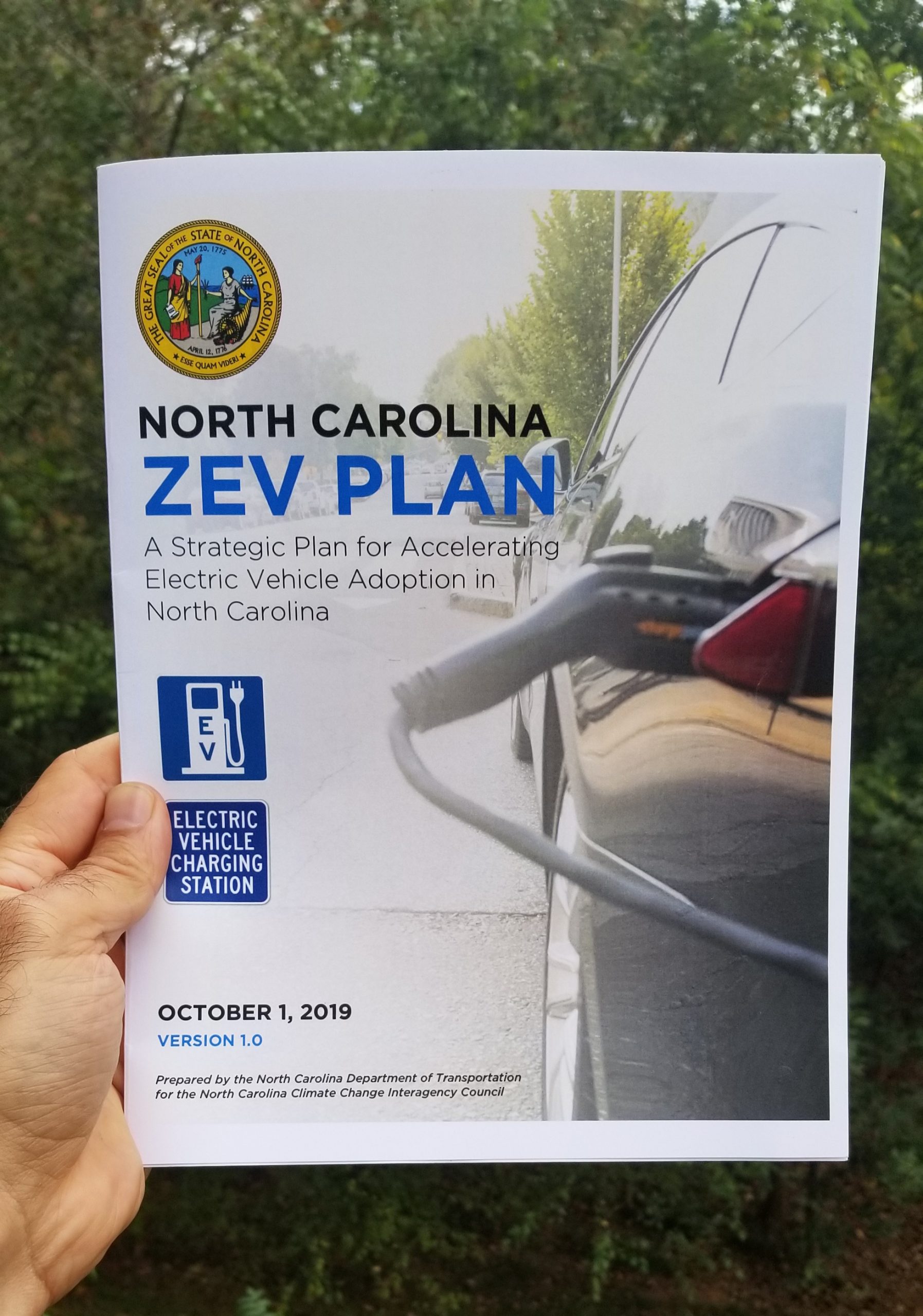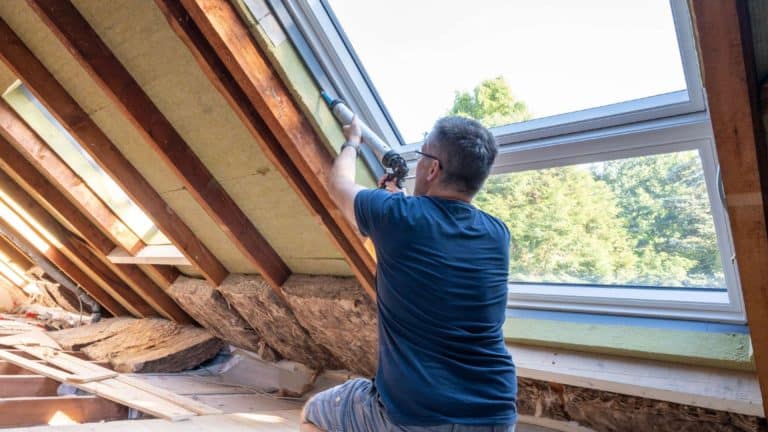North Carolina is a newly-established electric transportation leader. The Tarheel State’s newly released Zero Emission Vehicle 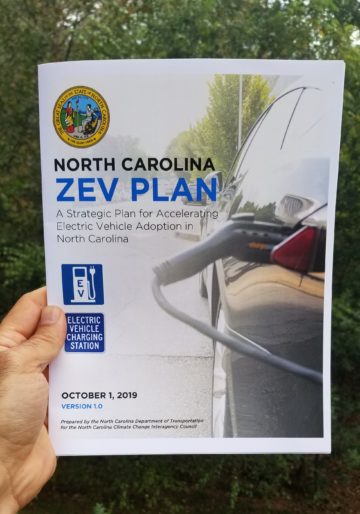 (ZEV) Plan is the first of its kind in the Southeast.
(ZEV) Plan is the first of its kind in the Southeast.
The Plan supports Governor Roy Cooper’s ambitious climate change and clean energy economy goals. The primary goal of the ZEV Plan is to increase the number of registered electric vehicles (EVs) in the state to at least 80,000 by 2025, an increase of approximately 500% from the number of EVs on North Carolina’s roads today.
The Plan’s impactful initiatives include:
- innovating utility rate design to scale charger deployment,
- establishing consumer purchase incentives such as state tax credits or rebates, and
- converting the state motor fleet to zero-emission vehicles.
This is exciting progress – and we applaud the process of public input that the NCDOT utilized in making the recommendations. We have suggestions to improve the implementation of the Plan, such as setting measurable time-bound targets and addressing opportunities identified by electric transportation stakeholders, that are addressed in this blog. First and foremost want to congratulate the state leaders who are taking bold steps to confront climate change.
Confronting Climate Change by Executive Order
Last week in Raleigh, North Carolina’s Governor, Roy Cooper, met with his Climate Change Interagency Council for a briefing on four reports: the Department of Environmental Quality’s Clean Energy Plan, Department of Commerce’s Clean Energy and Transportation Workforce Assessment, Department of Administration’s Motor Fleet Zero Emission Vehicle Plan, and the Department of Transportation’s Zero Emission Vehicle Plan. These plans culminated 11 months of work initiated by the Governor’s Executive Order 80, North Carolina’s commitment to address climate change and transition to a clean energy economy.
By 2025, Executive Order 80 seeks to accomplish the following:
- reduce statewide greenhouse gas emissions to 40% below 2005 levels;
- increase the number of registered ZEVs in the state to at least 80,000;
- reduce energy consumption per square foot in state-owned buildings by at least 40% from the fiscal year 2002-2003 levels.
These goals are the most ambitious in the Southeast and position North Carolina as a player on the national climate policy stage. “We are taking a significant step to put before this state a challenge, a challenge that we have to meet,” said Governor Cooper to the packed room at Friday’s Interagency Council’s meeting. “Our children and our grandchildren are depending on us to turn the tide of climate change.”
Earlier this year, the Intergovernmental Panel on Climate Change issued a report on global warming that, among other findings, raised the alarm that we have only a few decades left to curb greenhouse gas emissions or else run the risk of experiencing catastrophic consequences. “Every single North Carolinian from hurricane victims to farmers have felt the effects of climate change,” said Governor Cooper. “So, this is imperative for this administration because we know the challenges that lie ahead.”
Achieving these goals is feasible but will require fundamental changes to three main sectors:
- Built Environment — how we build, power, heat and cool buildings and homes
- Energy Sector — how we generate and consume electricity and other fuels
- Transportation — how we move and how we power that movement
Emphasizing the Transportation Sector
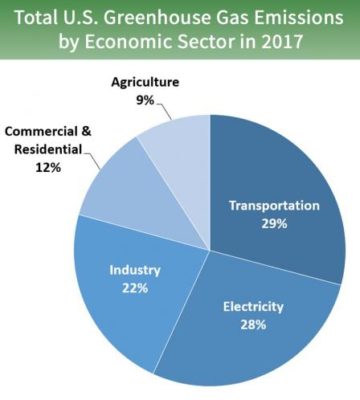 Greenhouse gas emissions from travel – air, ground, and sea – are now America’s largest source of greenhouse gas emissions.
Greenhouse gas emissions from travel – air, ground, and sea – are now America’s largest source of greenhouse gas emissions.
Until recently, automobile emission reduction gains came from increases in fuel economy standards, incremental improvements in vehicle efficiency, and reductions in vehicle miles traveled through investments in public transportation. With light and medium-duty ZEV sales accelerating across the country, and heavy-duty trucks entering the market, ZEVs are the most promising and scalable technology to decarbonize the sector. ZEV is a catchall term that includes heavy-duty vehicles such as tractor-trailers; medium-duty vehicles such as electric buses; and light-duty electric vehicles (both full battery EVs such as the Nissan LEAF, Chevy Bolt, and Tesla Model 3, as well as plug-in hybrids that have both batteries and back-up gas generators such as the Chevy Volt, Toyota Prius Prime and Honda Clarity).
Over the past few years, North Carolina has risen to one of the fastest-growing light-duty ZEV markets in the country; NC ranked 8th nationally, achieving 129.29% year-over-year sales growth 2017-2018 and topping the 1% market penetration threshold. There are approximately 14,000 ZEVs registered in NC currently. Executive Order 80 seeks to grow that number to at least 80,000 by 2025. The North Carolina ZEV Plan targets emission reductions from the light, medium, and heavy-duty vehicles we drive ride in and that deliver our goods and services.
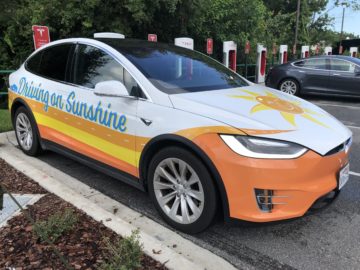 From a climate perspective, increasing the number of ZEVs on North Carolina roads is impactful. Compared to an internal combustion engine (ICE), ZEVs reduce greenhouse gas emissions by upwards of 60% if powered by today’s utility resources – and this percentage will only increase as our electric grid becomes cleaner and more efficient – ultimately reaching 100% if the vehicle is charged on renewable energy.
From a climate perspective, increasing the number of ZEVs on North Carolina roads is impactful. Compared to an internal combustion engine (ICE), ZEVs reduce greenhouse gas emissions by upwards of 60% if powered by today’s utility resources – and this percentage will only increase as our electric grid becomes cleaner and more efficient – ultimately reaching 100% if the vehicle is charged on renewable energy.
Beyond the climate benefits, ZEVs also:
- enhance energy security by diversifying transportation fuel away from our dependence on oil;
- cost approximately $1,300/year less annually because electricity is cheap (vs. gas), and because ZEVs require virtually no maintenance;
- help poise municipal and state governments to save significant taxpayer dollars by electrifying car and bus fleets;
- retain community wealth because most of the money spent on gas and diesel in the Southeast is exported to oil-producing states and nations;
- spread utility capital cost recovery over a larger user base, which has the potential to put downward pressure on electricity rates if coupled with smart rate design.
The ZEV Plan is a Work in Progress
Governor Cooper tasked the Department of Transportation (DOT) to develop a plan that would establish state-wide vehicle corridors, install needed vehicle charging infrastructure, and increase EV adoption to at least 80,000 registered electric vehicles. DOT solicited input from the general public and industry stakeholders that helped shape the plan’s outcome. This engagement process was necessary because, at the start, DOT lacked electric transportation knowledge, experience, and expertise. Whereas the Department of Environmental Quality understands clean energy, the Department of Administration vehicle procurement, and the Department of Commerce workforce development, DOT knows highways, rail, aviation, ferries, public transit, and bicycle and pedestrian transportation, but not ZEVs. The ZEV Plan is the result of a collaborative effort, and DOT should be commended for leading. The final Plan advocates for impactful initiatives:
- Social and economic benefits
- improve public health by reducing tailpipe air pollutants
- create job growth in the electric transportation sector
- ensure equitable access to clean transportation technologies and their benefits
- ZEV sales and market share increase
- explore financial incentives such as tax credits and rebates
- encourage the affordable used ZEV market
- convert to electric transit bus fleets
- transition to ZEVs in the State’s light-duty motor fleet through the Department of Administration’s Motor Fleet ZEV Plan
- Charging infrastructure increases needed to support ZEV mobility
- develop workplace charging programs
- update state building code to require all new construction prepare for charging station installation
- and innovate ZEV charging utility rate design to support utility and private sector investment
Room for Improvement
The Plan will be improved by considering additional recommendations put forth by electric transportation advocates and businesses:
- Targets — Set specific, measurable, achievable, realistic, and time-bound goals for each recommendation in the ZEV Plan. Absent of such targets, success will be challenging to measure, and continual improvement challenging to manage.
- Utility Engagement — Support utility investment in ZEV charging infrastructure, like what Duke Energy proposed earlier this year in their $76 million NC Electric Transportation Pilot filing. Help the N.C. Utility Commission and State Legislature understand the scope and scale of charging infrastructure investment required to transition to more energy secure, lower cost and cleaner electric transportation for all North Carolinians.
- ZEV Mandate — Advocate for North Carolina to join the 10 states that have set ZEV mandates requiring auto manufacturers and dealerships to promote and make all ZEV models available. Consumers in the ZEV Mandate states have access to EV models and deals and incentives that are not currently available in North Carolina, leaving North Carolinians without equal access and choice.
- School Buses — Along with transit buses, school buses should be converted to electric. Electric school buses improve the health of school children and residents in proximity to bus depots by reducing their exposure to diesel exhaust, and significantly reduce fuel and operating costs for school districts across the state.
- Mountains to the Sea — Ensure that all North Carolinians, including those living in rural towns and disadvantaged communities, are connected to the growing network of fast changing infrastructure deployed by private companies, Volkswagen Settlement funds, and utilities. Where fast charging gaps exist, take responsibility for filling those gaps, so no communities are left behind.
Getting off the Starting Line
We are racing against the climate clock, which requires that we muster a pace of urgency not typical of transformative state-wide initiatives. Transitioning from planning to implementation will be a much more significant challenge than drafting the ZEV Plan. There are financial, political, regulatory, and policy barriers to overcome. There is a need to educate consumers, policymakers, and regulators to raise awareness of electric transportation technology and the benefits of ZEVs.
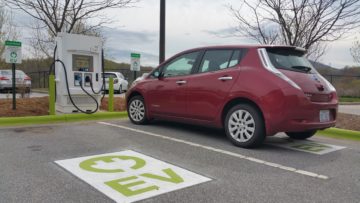 Transitioning to electric transportation means disrupting how we power and manage mobility. As with any technology disruption, there are winners and losers. Advocates, research groups, infrastructure companies, auto manufacturers, auto dealerships, electric utilities, utility commissioners, state agencies, and policymakers need to work collaboratively to maximize the transition’s gains while minimizing disruption challenges. DOT would be wise to establish a ZEV Plan Advisory Group that draws off of in-state electric transportation expertise to help guide and support implementation. Implementing the ZEV Plan represents climate action; the work is intricate, collaboration is critical, and the time is short.
Transitioning to electric transportation means disrupting how we power and manage mobility. As with any technology disruption, there are winners and losers. Advocates, research groups, infrastructure companies, auto manufacturers, auto dealerships, electric utilities, utility commissioners, state agencies, and policymakers need to work collaboratively to maximize the transition’s gains while minimizing disruption challenges. DOT would be wise to establish a ZEV Plan Advisory Group that draws off of in-state electric transportation expertise to help guide and support implementation. Implementing the ZEV Plan represents climate action; the work is intricate, collaboration is critical, and the time is short.
The ZEV Plan marks the beginning of the race. As Governor Cooper said in his concluding remarks last week, “This is the start of something big for our state… At the end of the day, we are going to win this [climate] fight because we are fighting on the side of what is true, what is right, and what is best for the people of this state.”
